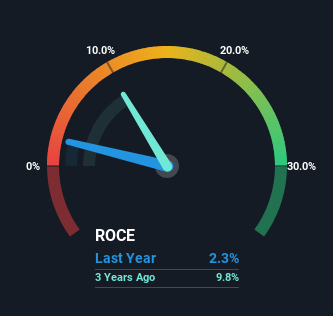If you're looking for a multi-bagger, there's a few things to keep an eye out for. Firstly, we'll want to see a proven return on capital employed (ROCE) that is increasing, and secondly, an expanding base of capital employed. Ultimately, this demonstrates that it's a business that is reinvesting profits at increasing rates of return. In light of that, when we looked at SoftBlue (WSE:SBE) and its ROCE trend, we weren't exactly thrilled.
Understanding Return On Capital Employed (ROCE)
For those who don't know, ROCE is a measure of a company's yearly pre-tax profit (its return), relative to the capital employed in the business. Analysts use this formula to calculate it for SoftBlue:
Return on Capital Employed = Earnings Before Interest and Tax (EBIT) ÷ (Total Assets - Current Liabilities)
0.023 = zł1.5m ÷ (zł85m - zł21m) (Based on the trailing twelve months to March 2023).
Thus, SoftBlue has an ROCE of 2.3%. In absolute terms, that's a low return and it also under-performs the IT industry average of 11%.
Check out our latest analysis for SoftBlue

Historical performance is a great place to start when researching a stock so above you can see the gauge for SoftBlue's ROCE against it's prior returns. If you're interested in investigating SoftBlue's past further, check out this free graph of past earnings, revenue and cash flow.
What Does the ROCE Trend For SoftBlue Tell Us?
On the surface, the trend of ROCE at SoftBlue doesn't inspire confidence. Over the last five years, returns on capital have decreased to 2.3% from 4.5% five years ago. On the other hand, the company has been employing more capital without a corresponding improvement in sales in the last year, which could suggest these investments are longer term plays. It's worth keeping an eye on the company's earnings from here on to see if these investments do end up contributing to the bottom line.
The Bottom Line On SoftBlue's ROCE
Bringing it all together, while we're somewhat encouraged by SoftBlue's reinvestment in its own business, we're aware that returns are shrinking. Since the stock has gained an impressive 42% over the last five years, investors must think there's better things to come. Ultimately, if the underlying trends persist, we wouldn't hold our breath on it being a multi-bagger going forward.
One more thing, we've spotted 1 warning sign facing SoftBlue that you might find interesting.
While SoftBlue may not currently earn the highest returns, we've compiled a list of companies that currently earn more than 25% return on equity. Check out this free list here.
New: Manage All Your Stock Portfolios in One Place
We've created the ultimate portfolio companion for stock investors, and it's free.
• Connect an unlimited number of Portfolios and see your total in one currency
• Be alerted to new Warning Signs or Risks via email or mobile
• Track the Fair Value of your stocks
Have feedback on this article? Concerned about the content? Get in touch with us directly. Alternatively, email editorial-team (at) simplywallst.com.
This article by Simply Wall St is general in nature. We provide commentary based on historical data and analyst forecasts only using an unbiased methodology and our articles are not intended to be financial advice. It does not constitute a recommendation to buy or sell any stock, and does not take account of your objectives, or your financial situation. We aim to bring you long-term focused analysis driven by fundamental data. Note that our analysis may not factor in the latest price-sensitive company announcements or qualitative material. Simply Wall St has no position in any stocks mentioned.
About WSE:SBE
SoftBlue
Provides IT solutions and consulting services for technologies, research, and scientific projects.
Flawless balance sheet with very low risk.
Market Insights
Community Narratives



